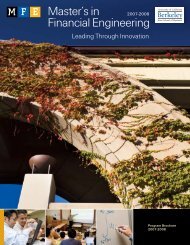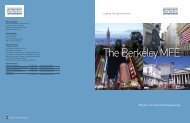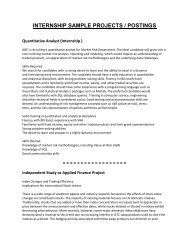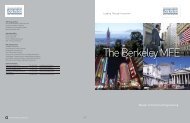The Berkeley MFE.pdf - Master of Financial Engineering Program
The Berkeley MFE.pdf - Master of Financial Engineering Program
The Berkeley MFE.pdf - Master of Financial Engineering Program
You also want an ePaper? Increase the reach of your titles
YUMPU automatically turns print PDFs into web optimized ePapers that Google loves.
<strong>MFE</strong> 230Q – Introduction to Stochastic<br />
Calculus (and Numerical Methods in<br />
Finance). This course presents the concepts<br />
and tools <strong>of</strong> stochastic calculus<br />
as required for effective pricing <strong>of</strong> complex<br />
financial derivatives in continuous<br />
time, and introduces the fundamentals<br />
<strong>of</strong> elementary numerical analysis. <strong>The</strong><br />
course stresses the practical applications<br />
<strong>of</strong> stochastic differential equations, Ito<br />
integrals, and measure transformations<br />
as required for advanced financial engineering<br />
practice and understanding <strong>of</strong><br />
asset pricing theory.<br />
<strong>MFE</strong> 230R – Advanced Computational<br />
Finance. This course is a deeper analysis<br />
<strong>of</strong> numerical and computational issues<br />
in pricing and calibration, and builds on<br />
the techniques learned in Derivatives:<br />
Quantitative Methods. Emphasis is on<br />
hands-on case projects with heavy use <strong>of</strong><br />
computational techniques.<br />
<strong>MFE</strong> 230S – Behavioral Finance. This<br />
course covers elements <strong>of</strong> behavioral<br />
decision theory and its implication in<br />
financial markets. Focus is on the psychological<br />
processes by which people make<br />
judgments and decisions, and the heuristics<br />
and biases associated with these<br />
decisions.<br />
<strong>MFE</strong> 230V – Credit Risk Modeling. <strong>The</strong><br />
course provides exposure to the practical<br />
challenges associated with building<br />
and testing credit risk models for use by<br />
banks and asset managers. Emphasis is<br />
placed on model building, model valuation,<br />
and interpreting model output.<br />
<strong>MFE</strong> 230W – Accounting and Taxation<br />
<strong>of</strong> Derivatives. <strong>The</strong> broad purpose <strong>of</strong><br />
this course is to help financial engineers<br />
understand the implications <strong>of</strong> the innovative<br />
financial instruments that they construct<br />
on firms’ financial statements and<br />
tax liability.<br />
Practice Seminars I and II. <strong>The</strong>se weekly<br />
seminars feature guest speakers from<br />
financial services firms discussing the<br />
work <strong>of</strong> financial engineers in their firms<br />
and the kinds <strong>of</strong> skills and personal<br />
attributes they are seeking for this work,<br />
trends in the provision <strong>of</strong> financial services,<br />
the information and computing<br />
systems being adopted, new product<br />
developments, regulatory issues, and<br />
similar topics.<br />
Interns, Morgan Stanley<br />
Ariel Pavlicevich<br />
<strong>MFE</strong> 08 (left)<br />
Morgan Stanley<br />
New York, New York<br />
Previous degree:<br />
BS, Computer Science and <strong>Engineering</strong><br />
University <strong>of</strong> California, Los Angeles<br />
“<strong>The</strong> Haas <strong>MFE</strong> <strong>Program</strong> utilizes the entire<br />
UC community as well as leading practitioners<br />
to assemble a first-class faculty focused<br />
on teaching the tools and intuition essential<br />
for a successful future in financial engineering.<br />
<strong>The</strong> education process extends beyond<br />
the classroom where group work encourages<br />
students analyze problems, assimilate ideas,<br />
and to effectively collaborate, ensuring a<br />
seamless transition into the workforce.”<br />
June Lin<br />
<strong>MFE</strong> 08 (second from left)<br />
Morgan Stanley<br />
New York, New York<br />
Previous degrees:<br />
MS, Computer Science<br />
College <strong>of</strong> William and Mary<br />
MS, Electrical <strong>Engineering</strong><br />
Shanghai Jiao Tong University, China<br />
BA, Electrical <strong>Engineering</strong> and Applied Mathematics<br />
Shanghai Jiao Tong University, China<br />
“<strong>The</strong> <strong>Berkeley</strong> one-year intense <strong>MFE</strong><br />
<strong>Program</strong> provides an excellent option for<br />
pr<strong>of</strong>essionals looking to break into the competitive<br />
quantitative finance field.”<br />
Atanas Vanchev<br />
<strong>MFE</strong> 08 (second from right)<br />
Morgan Stanley<br />
London, England<br />
Previous degree:<br />
BS, Mathematics<br />
Purdue University<br />
“I found the Haas <strong>MFE</strong> <strong>Program</strong> to be<br />
extremely challenging and rewarding. <strong>The</strong><br />
assigned projects and homework assignments<br />
have given me the opportunity to<br />
interact and collaborate with very bright<br />
students and pr<strong>of</strong>essors and to develop<br />
lasting relationships. If I had to choose a<br />
financial engineering program again, it<br />
would be the Haas <strong>MFE</strong> without a doubt.”<br />
Feng Ning<br />
<strong>MFE</strong> 08 (right)<br />
Morgan Stanley<br />
London, England<br />
Previous degree:<br />
BS, Electrical <strong>Engineering</strong> and Computer Science<br />
University <strong>of</strong> California, <strong>Berkeley</strong><br />
“<strong>The</strong> <strong>MFE</strong> <strong>Program</strong>’s emphasis on financial<br />
intuition, econometric rigor, and practical<br />
business application was a perfect complement<br />
to my quantitative electrical engineering<br />
background.”<br />
9











